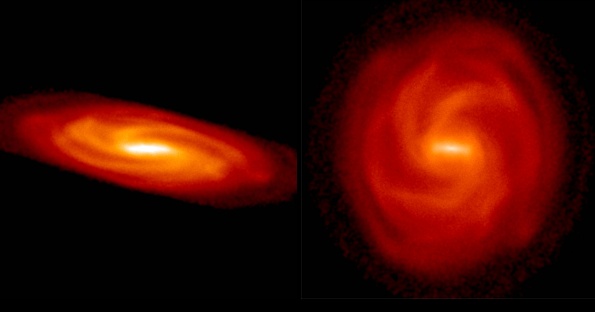Local Dark Matter/A Hundred Years of Cosmic Rays
August 17, 2012
Congratulations to
NASA on the successful August 6, 2012, landing of the
Curiosity rover at
Gale crater on
Mars. Since I've already reviewed this rover and Gale crater in a
previous article (Gale Crater, August 31, 2011), this article will be about other things
astronomical. When Curiosity locates the
Alchemists of Mars, I'll write another article.
The nature of
dark matter is our current
cosmic mystery. The dark matter mystery started in the 1930s, when
astronomers discovered that our
Milky Way Galaxy contained more
mass than the sum of its
stars. Observations of other
galaxies, through measurement of their
rotation rates and
orbital velocities in
clusters, showed the same effect.
This "missing mass" problem persists now, eighty years later, renamed as dark matter. True to its appellation, dark matter can't be observed by
telescopes. It neither
emits nor
absorbs electromagnetic radiation. We can only infer its presence indirectly, as was done with the
Wilkinson Microwave Anisotropy Probe. The measurements indicate that 83% of the
matter in our present
universe is dark matter.
It's been eighty years, but
scientists should be confident that the mystery of dark matter will be solved. They just need to look at the history of
cosmic rays, which were just as mysterious when they were discovered a hundred years ago. As usual, the big mystery of cosmic rays arose when some little mysteries were found to be linked.
Alan Watson,
emeritus professor of
physics at the
University of Leeds, has written an article on the history of cosmic rays in the current issue of
Physics World.[1-2]
The first little mystery appeared in the 1780s, at the time when experiments on
electrostatics were a popular pastime among
physicists.
French physicist
Charles-Augustin de Coulomb, for whom the
unit of electric charge is named, found that an isolated
charged sphere in
air would slowly lose its charge. This was curious, since air was supposed to be an
insulator.[1] Years later, after the discovery of
X-rays by
Wilhelm Röntgen in 1895, it was found that air
molecules would become charged upon X-ray exposure.
An obvious
experiment at that point would be to examine the charge state of air in a
lead vessel. The lead, of course, would block
radiation such as X-rays. Surprise! The air still became ionized. To determine whether this ionization was caused by a substance in the
Earth, or elsewhere, the
Austrian (eventually,
American) scientist,
Victor Hess, took a
balloon to an
altitude of five
kilometers and found that the ionization happened at three times the rate at ground level. That was on August 7, 1912, and Hess shared the 1936
Nobel Prize in Physics for his discovery of "cosmic radiation."[1]

Victor Hess, returning from his balloon flight on August 7, 1912.
(American Physical Society photograph, via Wikimedia Commons)
Cosmic rays are
nuclei of the
elements that apparently travel at
near-light-speeds for millions of years before they reach the Earth. That puts the source of cosmic rays at quite a distance, and the source has not been identified.[1] In the category of what are the chances of that, there was one famous cosmic ray, a
platinum nucleus, that was detected in 1975 and at first thought to be a
magnetic monopole.[3] There are quite a few
cosmic ray observatories in operation, today, trying to locate the source of the highest energy cosmic rays, but we know much more about them than a hundred years ago.[1]
Theory predicts that there should be 400-1000
grams of dark matter in the Sun's vicinity in a volume the size of the Earth, but dark matter particles have still not been detected on Earth. In a
recent article (A Dearth of Dark Matter, April 23, 2012), I reviewed a study by astronomers at the
European Southern Observatory that measured the motion of stars distant from the
plane of our galaxy to infer the concentration of dark matter.
Through observations of the motions of more than 400
red giant stars in a volume out to 13,000
light years, they found that dark matter is remarkably absent from the region of space around our
solar system.[4-5] It's not the expected 400-1000 grams per Earth volume, but essentially zero within an
error of 70 grams.[4]
In what reminds me of the endless cycle of studies that find that
coffee is first good for you, then bad, then good, another study has concluded that dark matter is abundant near the Earth.[5-7] In this study, just published online in the
Monthly Notices of the Royal Astronomical Society, an international team of astronomers has used existing data on the motions and positions of about two thousand
K dwarf stars to determine the local matter density of our part of the galaxy. Their results are consistent with the prevailing idea that a halo of dark matter surrounds our Milky Way Galaxy.[6]
This conclusion is based on a considerable amount of
number crunching using a
Monte Carlo Markov chain model.[7] The model was tested by using a dynamically evolved N-body simulation of the Milky Way as a testbed.[7] The study found a local dark matter density of 0.022-0.025
solar masses per cubic parsec, depending on what correction factors are applied.[8]

High resolution computer simulation of the Milky Way showing mass distribution. University of Zurich images (left; right).[6)]
Says team leader,
Silvia Garbari, of the
Institute for Theoretical Physics,
University of Zurich, "We are 99% confident that there is dark matter near the Sun."[6] Garbrai's colleague,
George Lake, who is also an author of the Monthly Notices paper, elaborated,
"If dark matter is a fundamental particle, billions of these particles will have passed through your body by the time you finish reading this article. Experimental physicists hope to capture just a few of these particles each year in experiments like XENON and CDMS currently in operation. Knowing the local properties of dark matter is the key to revealing just what kind of particle it consists of."[6]
References:
- 100 years of cosmic rays mystery, Institute of Physics Press Release, July 31, 2012.
- Alan Watson, "100 years of cosmic rays," Physics World, Aug 1, 2012.
- Luis W. Alvarez, "Analysis of a Reported Magnetic Monopole," in Proceedings of the 1975 international symposium on lepton and photon interactions at high energies. International symposium on lepton and photon interactions at high energies, W. T. Kirk, Ed., August 21, 1975. pp. 967, as cited in Wikipedia.
- Serious Blow to Dark Matter Theories? New study finds mysterious lack of dark matter in Sun's neighbourhood, European Southern Observatory Press Release eso1217, April 18, 2012.
- C. Moni Bidin, G. Carraro, R. A. Mendez, R. Smith, "Kinematical and chemical vertical structure of the Galactic thick disk II. A lack of dark matter in the solar neighborhood," arXiv Preprint Server, April 17, 2012.
- Plenty of dark matter near the Sun, University of Zurich Press Release, August 9, 2012.
- Silvia Garbari, Chao Liu, Justin I. Read and George Lake, "A new determination of the local dark matter density from the kinematics of K dwarfs," Monthly Notice of the Royal Astronomical Society, Prepublication, August 9, 2012.
- Silvia Garbari, Chao Liu, Justin I. Read and George Lake, "A new determination of the local dark matter density from the kinematics of K dwarfs," arXiv Preprint Server, July 23, 2012.
Permanent Link to this article
Linked Keywords: NASA; Curiosity rover; Gale crater; Mars; astronomy; The Alchemists of Mars; dark matter; cosmology; astronomer; Milky Way Galaxy; mass; star; galaxy; rotation rate; orbital velocity; cluster; telescope; emission spectrum; absorption spectroscopy; electromagnetic radiation; Wilkinson Microwave Anisotropy Probe; matter; universe; scientist; cosmic ray; Alan Watson; emeritus professor; physics; University of Leeds; Physics World; electrostatics; physicist; France; French; Charles-Augustin de Coulomb; unit of electric charge; charge; atmosphere of Earth; air; electrical insulator; X-ray; Wilhelm Röntgen; molecule; experiment; lead; radiation; Earth; Austria; Austrian; United States; American; Victor Hess; balloon; altitude; kilometer; Nobel Prize in Physics; American Physical Society; Wikimedia Commons; atomic nucleus; chemical element; speed of light; near-light-speed; platinum; magnetic monopole; cosmic-ray observatory; theory; gram; European Southern Observatory; galactic plane; red giant; light year; solar system<; standard error; coffee; Monthly Notices of the Royal Astronomical Society; K-type main-sequence star; K dwarf star; supercomputer; number crunching; Markov chain Monte Carlo; Monte Carlo Markov chain; computer simulation; computer model; solar mass; University of Zurich; Silvia Garbari; Institute for Theoretical Physics; George Lake; XENON; CDMS.